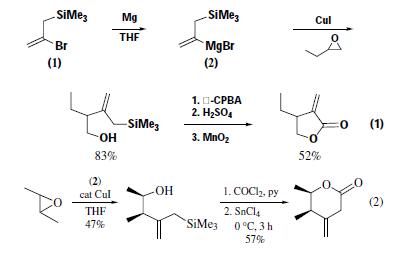(2-BROMOALLYL)TRIMETHYLSILANE Chemische Eigenschaften,Einsatz,Produktion Methoden
R-Sätze Betriebsanweisung:
R10:Entzündlich.
R36/37/38:Reizt die Augen, die Atmungsorgane und die Haut.
S-Sätze Betriebsanweisung:
S16:Von Zündquellen fernhalten - Nicht rauchen.
S26:Bei Berührung mit den Augen sofort gründlich mit Wasser abspülen und Arzt konsultieren.
S36:DE: Bei der Arbeit geeignete Schutzkleidung tragen.
Physikalische Eigenschaften
bp 46–50°C/20 mmHg,64–65°C/38–
39 mmHg.
Verwenden
2-Bromo-3-trimethylsilyl-1-propene can be used as synthon for CH2=C?CH2TMS1–3 and CH2=CBrC?H2;2 for
synthesis of 1-trimethylsilylmethyl-substituted 1,3-butadienes.
The 1-trimethylsilylmethylvinyl
anion CH2=C(M)CH2TMS (2) (M = Li, Mg, Cu,
etc.), readily prepared from 2-bromo-3-trimethylsilyl-1-propene
(1) under typical conditions, allows the introduction of the
synthetically useful 1-trimethylsilylmethylvinyl group to a wide
variety of substrates. Ring opening of 1-butene oxide with the
Grignard reagent (2) (M = MgBr) in the presence of copper(I)
iodide gives only one regioisomer. Subsequent desilylative oxidation
of this allyl alcohol to α-methylene-γ-lactones provides
further utility of (1) as a 1-hydroxymethylvinyl anion equivalent,
i.e. CH2=?C?CH2OH (eq 1).Alternatively, the alcohol
from trans-2,3-epoxybutane provides a route to the unstable sixmembered
β,γ-unsaturated lactone (eq 2).The copper-catalyzed
1,4-addition to the typically unreactive mesityl oxide proceeds
smoothly. The versatility of the allylsilane moiety is again illustrated
in the ethylaluminum dichloride-induced cyclization of the
adduct to a tertiary cyclopentanol in high yield (eq 3).

synthetische
reaction of 2,3-dibromopropene
with lithium (trimethylsilyl)cuprate in HMPA at 0°C
(63–90%);(2) reaction of 2,3-dibromopropene with trichlorosilane
in the presence of trichlorosilane and copper(
I) chloride, followed by treatment with methylmagnesium
bromide (63–71%).
läuterung methode
It is fractionally distilled through an efficient column. It is flammable. [Trost & Chan J Am Chem Soc 104 3733 1982, Trost & Coppola J Am Chem Soc 104 6879 1982.]
(2-BROMOALLYL)TRIMETHYLSILANE Upstream-Materialien And Downstream Produkte
Upstream-Materialien
Downstream Produkte

